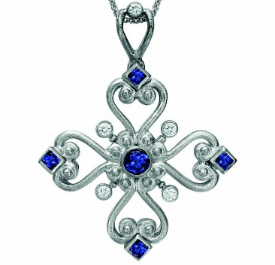
Aegean Collection
In the 2nd and 3rd century BC a civilization flourished on the Mediterrnean Island of Crete known as the Minoans. The Minoans are credited with creating finely crafted miniature gold charms of various motifs which they meticulously arranged and made into fine jewelry. These pieces of jewelry quickly became works of art. Stimulated by their intense gold working activity the Minoans became quite wealthy. The art of fine jewelry making spread from the Minoans of Crete to the other islands and onto the mainland.
Click Here to View
Etruscan Collection
It is believed that the most complete form of acquired art from the third millennium BC was that of the Etruscan jewelers. The Etruscan gold workers mastered the most sophisticated of techniques, known as repousse, filigree, and granulation. To the Etruscans jewelry was a status symbol of wealth and prosperity.
Click Here to View
Honey Collection
The honeycomb is a timeless design pattern used in fine jewelry for centuries. Ancient fine metal workers often used a bonded rope design to compliment the honeycomb pattern It was quite popular to embellish the jewelry with large cabochons. Honeycomb patterned jewelry lends itself to the use of mixed metals. The hexagonal shape of the honeycomb is both fluid and rigid so it can be surrounded by various patterns and motifs. There is nothing more stunning than a honeycomb patterned bracelet in richly hued yellow gold.
Click Here to View
Perle Collection
The pearl has been associated with love and marriage down through the centuries. Before the creation of cultured pearls in the early 1900’s natural pearls were so rare and expensive that they were reserved almost exclusively for the noble and very rich. A natural pearl necklace of matching pearls was one of the most expensive pieces of jewelry in the world.
Click Here to View
Roman Collection
The Romans used a diverse selection of materials in their jewelry due to the accessibility of a wide variety of natural resources found across the European and Mediterranean Continents. The trade routes through the Roman Empire provided the jewelers with precious gemstones from India and the Far East. The use of these magnificent gemstones became the standard in Roman jewelry from that era.
Click Here to View
Antioch Collection
Fine metal working is an ancient art form with a rich history dating back to earliest cultures and civilizations. Scholars speculate that gold was the “first metal” because it is pure and malleable out of the ground. Early artisans were very skilled at creating objects of adornment, religion, and artifacts out of gold.
Click Here to View
